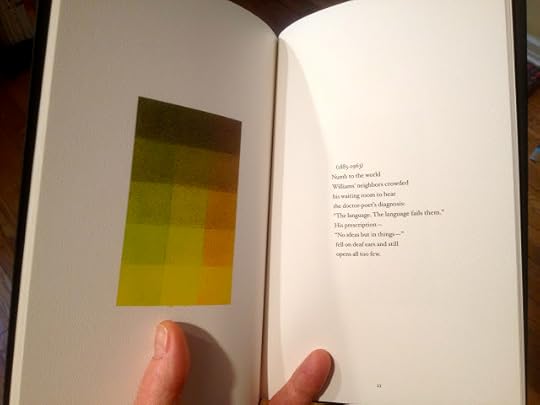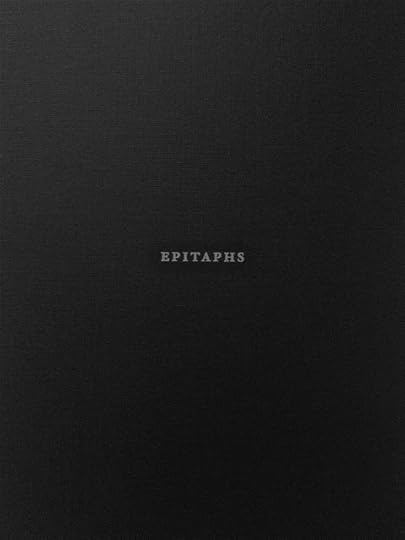A Cenotaph of Words

On Saturday, before meeting Markus Leikola (which is a story I will leave for later, maybe tomorrow), I went to The Strand in New York City to search through the poetry section there. Even though that store has a large poetry section, it never has much that I want to purchase. But its selection changes constantly, and that day I picked two books off a cart before they had ever been shelved, one of them a copy of a book created by two friends of mine (along with another co-conspirator). I left with nine books, three of which I've already read, and I'm halfway through another. I am a reader.
At The Strand, I ran into my friend Ben McFall, whom I didn't expect to see there since he usually doesn't work on Saturdays. Actually, I was walking past him when he said,
"Hello, Geoffrey."
"Ben!" I exclaimed, "What are you doing here? When I'd made it home, I was going to send you a note telling you that I missed you again, because I always come here on Saturday."
We spoke for a few minutes about poetry and Jim Behrle, Ben's unlikely roommate. I told him that Jim, when visiting my apartment, had said one of the saddest things I'd ever heard anyone say: that mine was the nicest place he had ever seen. My place is neat, but nothing spectacular. (Ben intimated that it is possible that Jim is not the neatest of people.)
And the three of us are poets, of different types, but often thrown together, and that's what I like my reading to be: diverse, but still moving in the same general direction.
On a book table, resting near the poetry section, I found a copy of a book I knew I wanted immediately. It cost US$35, but reduced to US$31.50 at The Strand. It was a small book holding only a few handfuls of short poems, each paired with an en face (but after-the-fact) illustration by the author's first cousin.
So why did I buy it? First, because I follow the most famous teaching of Erasmus: "When I have a little money, I buy books; and if I have any left, I buy food and clothes." Second, because it was a beautifully printed and designed work of verbo-visual art. Printed on stiff watercolor paper with shimmering and colorful minimalist paintings. I could not avoid buying it.
Epitaphs by Gerald Jonas (as poet) and Sanford Wurmfeld (as painter) presents one of fifteen paintings by the latter on each of the verso pages of the book, except for the last page, and one of fifteen poems by the former, each poem in the form of epitaphs on each of the recto pages, except for the last. These paintings and poems were made independently and paired with each other later, yet they work together; they create wholes. The paintings are grids three across and five down (each adding up, you'll note, to fifteen) and each square of each grid is painted with washes of watercolor to present a myriad of color palettes and hues.
Each poem is an epitaph to a famous poet (except for the last), without ever fully naming that poet, so the reader is left to identify the W.S. of the first poem as Shakespeare along with Dickinson, Yeats, Stevens, Ginsberg, and even John Lennon, in a surprise appearance. The last poet is Gerald Jonas himself, who writes an epitaph, obviously, in advance of his own death. These poems carry, essentially as their titles, the birth and death dates of the poets, each pair of dates held in place within parentheses.
The poems themselves, appearing with various numbers of lines, do provide the brief outlines of the poets' lives, often with a well phrased twist, and always with verve, but they read to me as incomplete poems, sometimes too wry for their own good (such as when "unLennoned him" serves as the touching but goofy phrase that identifies John Lennon and notes his departure from this earth). Yet there is something inarguably tender about most of these poems, an honoring of these silenced voices, that seems right for epitaphs.
And the fifteen paletted squares that face each square often seem just right for their poems and the poet each memorializes. Emily Dickinson's, Wallace Steven's, and Sylvia Plath's seem just right to me, though the very light-hued greens and yellows and peaches of Edgar Allan Poe's is inappropriately bright.
It is a small book. I read it quickly, on Sunday, while sitting on a couch in the living room of my daughter and son-in-law's apartment in Astoria, but it has lingered on that other palate, the one that tastes words, and in the pulsing irises of my eyes, which are hazel, so they are of many varying colors, each unexpected color appropriate for a different time of the day.

_____
Jonas, Gerald and Sanford Wurmfeld. Epitaphs: Poems by Gerald Jonas, Paintings by Sanford Wurmfeld. GHP Media: np, 2012. US$40 with tax and shipping.
ecr. l'inf.
Published on May 22, 2012 17:53
No comments have been added yet.



